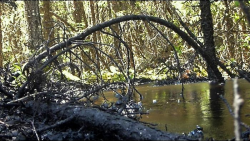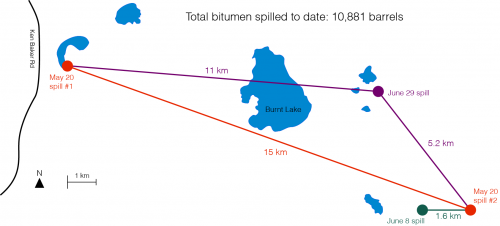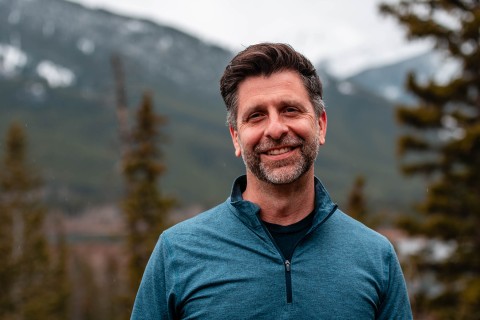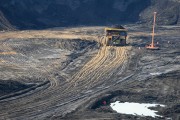In a drastic move to contain an on-going and unstoppable bitumen blowout in Cold Lake, Alberta, the province’s department of environment has ordered Canadian Natural Resource Ltd. (CNRL) to drain two thirds of a 53-hectare lake. According to CNRL, some of the removed water will be stored in the remaining one third of the lake, with the rest piped to a nearby pit and wetland.
Draining the water body will allow the company to seal the fissure currently seeping bitumen into the lake, and allow the Alberta Energy Regulator (AER) to compare it with three others on site. According to eyewitnesses, the fissures are as much as 150 meters in length.
In an online statement, CNRL said:
“We are at a phase in our restoration plan […] where we require access to the fissure below the shallow water body. We have determined the best regulatory approach to manage this work is through the Environmental Protection Order process. Canadian Natural requested and received an Environmental Protection Order for the 9-21 site from ESRD [Environment and Sustainable Resource Development].”
The order contradicts many of the public statements made by CNRL since the incident was made public: bitumen continues to seep from all four ground-fissures, none of the four leaking sites are contained, and the cause of the blowout remains unknown — as does information regarding how long the bitumen emulsion has actually been leaking.
Stretching the definition of reasonable
Section 112 of the Environmental Protection and Enhancement Act states that, upon the release of a substance that may cause adverse impacts to the environment, the company must take all reasonable measures to address its effects on the environment, prevent further impacts and return the environment to a “satisfactory condition." It’s under this rule that CNRL has received approval to drain the 53-hectare lake impacted by its in-situ operations.
The fact that CNRL must take drastic measures, including draining a water body, to deal with the impacts of their blowout highlights both the serious environmental damage caused by these incidents to date, as well as its ongoing impact on the environment.
In addition to the lake drainage, the order indicates that CNRL must adhere to a comprehensive remedial plan — including a wetlands impact assessment, water body restoration plan and a bitumen emulsion containment plan. Though new points of accountability have been created between the company and the Regulator, it is unclear to what extent any of the information will be made publically available.
Slow motion disaster
Remarkably, nearly 11,000 barrels of bitumen have seeped to the surface of the Cold Lake facility. This bitumen has soiled lakes and the surrounding ecosystem and has proven deadly to 214 animals. An unknown volume of bitumen and process affected water has moved out of the bitumen bearing formation and into groundwater bearing zones in the general area.
 New research from Timoney and Lee notes that CNRL’s spills present a more challenging clean up scenario than a pipeline spill, since they cause both damage deep underground and to the surface above ground. Our analysis of the spill locations provided in the Regulator’s Incident Reporting archive shows that the furthest distance between two spills is approximately fifteen kilometers, while the shortest distance is slightly more than one kilometer. The high-pressure nature of Cyclic Steam Stimulation technology has perhaps resulted in the bitumen emulsion following the path of least resistance through the formation’s rock and shale to the surface at four distinct areas on the Primrose and Wolf Lake lease.
New research from Timoney and Lee notes that CNRL’s spills present a more challenging clean up scenario than a pipeline spill, since they cause both damage deep underground and to the surface above ground. Our analysis of the spill locations provided in the Regulator’s Incident Reporting archive shows that the furthest distance between two spills is approximately fifteen kilometers, while the shortest distance is slightly more than one kilometer. The high-pressure nature of Cyclic Steam Stimulation technology has perhaps resulted in the bitumen emulsion following the path of least resistance through the formation’s rock and shale to the surface at four distinct areas on the Primrose and Wolf Lake lease.
The Regulator is leading the investigation into the cause of the bitumen releases to surface, and Environment Canada is assessing if any federal environmental or wildlife laws have been broken. However, these investigations have yet to include members of the public, members of the Cold Lake First Nations or interested stakeholder organizations, and no new information regarding the parameters of the investigation has been made available.
Community members left with unanswered questions
Communities have expressed concerns regarding the potential for aquifer contamination and the health of lands. Crystal Lameman of Beaver Lake Cree summed up her concerns this way:
“This area will never be the same and it shows the damage oilsands spills can cause and just how little we know about this type of underground technology.”
The Regulator’s decision to suspend and restrict steaming operations at the Primrose sites until they are satisfied that CNRL has fully identified the cause of the four distinct bitumen releases is a credible response to the incident. Moreover, its requirement that the company develop a plan to ensure releases of a similar nature do not re-occur on site is appropriate and timely. However, to date, the Regulator has withheld information needed by stakeholders and the public and First Nations to be confident in the investigation.
Transparent investigation processes are critical in order to gain public trust in the management of the oilsands. Unfortunately, the province has so far not included non-government organizations, First Nations, and nearby communities in its investigation at CNRL. These most recent events – including the drastic draining of a lake – bring new questions to the fore regarding the safety of CSS projects. As the spills continue to mount, so to will public concern over in-situ safety.










